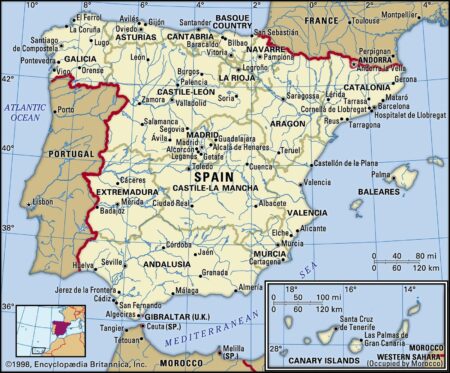In a pioneering move aimed at expanding global markets, live lobsters from Newfoundland and Labrador are now being flown directly to Spain, marking a significant milestone for the region’s seafood exporters. This new direct air route not only promises fresher product delivery but also signals the beginning of ambitious plans to strengthen and grow Newfoundland and Labrador’s presence in the competitive European seafood market. Exporters are optimistic that this development could pave the way for increased demand and broader international opportunities for the province’s prized marine exports.
Live Newfoundland Lobsters Reach Spanish Markets as Exporters Set Sights on Growth
In a historic first, live Newfoundland lobsters have arrived directly in Spain via air freight, marking a significant milestone for exporters eager to expand their European presence. This direct flight not only ensures the freshness and quality of the product but also shortens delivery times dramatically, making it an attractive option for high-end seafood markets. Industry leaders highlight that this move could open doors to increased demand in Spain and broader Mediterranean markets, potentially boosting Newfoundland’s seafood export revenues substantially.
Exporters are optimistic about the potential for growth, citing several advantages that could position Newfoundland lobsters as a premium choice in Spain, such as:
- Superior freshness owing to reduced transit time.
- Direct supply chain control enabling better pricing and quality assurance.
- Growing consumer demand for sustainably sourced, wild-caught seafood.
| Key Metrics | Value |
|---|---|
| Flight Duration | 5 hours (St. John’s to Madrid) |
| Export Volume (First Flight) | 2,000 live lobsters |
| Shipment Frequency | Twice weekly (projected) |
| Target Market Segments | High-end restaurants & gourmet retailers |
Ensuring Quality and Freshness in Direct Air Shipments Challenges and Innovations
Shipping live lobsters directly by air from the cold waters of Newfoundland to Spain presents a complex logistical puzzle that demands uncompromising standards. Temperature control is paramount; maintaining a steady hold of just above freezing ensures lobsters remain lively without risk of freezing, which would compromise both texture and taste. Innovative packaging solutions, such as insulated, moisture-controlled containers with oxygen flow systems, have been spearheading the way for this transatlantic journey. These technologies not only enhance survival rates but also extend shelf life, giving Spanish seafood markets access to the freshest possible product just hours after catch.
However, the challenges go beyond packaging. Coordination between air carriers, customs, and distributors requires precise timing to prevent delays that could jeopardize quality. Exporters are increasingly turning to real-time tracking systems, allowing all stakeholders to monitor environmental conditions and shipment progress live – an innovation critical to managing risks promptly. The table below outlines some key factors positively impacting lobster freshness while adapting to evolving air shipment practices:
| Factor | Benefit | Innovation |
|---|---|---|
| Temperature Stability | Prevents stress and maintains texture | Advanced insulated containers |
| Oxygen Flow | Supports respiration during transport | Controlled atmosphere packaging |
| Real-time Tracking | Allows immediate corrective actions | IoT sensors and data analytics |
| Time Efficiency | Shortens journey for peak freshness | Coordinated air freight scheduling |
Strategic Recommendations for Expanding North American Seafood Exports to Europe
Capitalizing on the successful direct air shipments of live Newfoundland lobsters to Spain, exporters should focus on building robust partnerships with European distributors to ensure consistent supply and market penetration. Emphasizing traceability and sustainability certifications can differentiate North American seafood in a competitive market increasingly driven by consumer demand for eco-conscious products. Establishing dedicated logistic hubs in key European cities will streamline distribution and reduce transit times, preserving product freshness and quality-critical factors for seafood success.
In addition, exporters must adopt a multifaceted marketing strategy that highlights the unique provenance and premium quality of North American lobsters. This includes targeted campaigns across digital platforms, participation in European seafood trade shows, and collaborations with local chefs and influencers to build brand recognition. To support these efforts, consider the following:
- Investing in cold chain technologies to maintain product integrity during transport
- Leveraging online B2B marketplaces to expand reach rapidly
- Customizing packaging to appeal to diverse cultural preferences
- Monitoring regulatory changes in EU seafood import policies
| Key Action | Benefit | Timeline |
|---|---|---|
| Establish European Distribution Hubs | Faster delivery, improved freshness | 6-12 months |
| Secure Sustainability Certifications | Market differentiation | 3-6 months |
| Digital Marketing Campaigns | Increased brand visibility | Ongoing |
| Engage with Local Seafood Chefs | Consumer trust and endorsement | 3-9 months |
Closing Remarks
As Canadian exporters begin shipping live lobsters directly to Spain, industry insiders are optimistic that this move will open new markets and strengthen international demand for East Coast seafood. While it remains early days, the successful flights mark a promising step toward expanding global reach and boosting the maritime economy. Stakeholders will be closely watching how this initiative evolves, hopeful that today’s flights herald bigger opportunities tomorrow.




